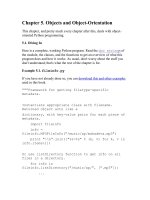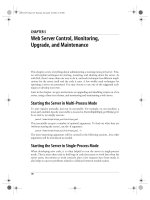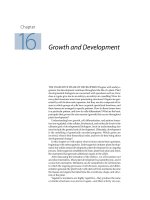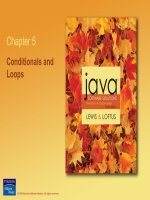Chapter 5 Conditionals and Loops pot
Bạn đang xem bản rút gọn của tài liệu. Xem và tải ngay bản đầy đủ của tài liệu tại đây (409.07 KB, 74 trang )
Chapter 5
Conditionals and
Loops
© 2004 Pearson Addison-Wesley. All rights reserved 5-2
Conditionals and Loops
•
Now we will examine programming statements that
allow us to:
make decisions
repeat processing steps in a loop
•
Chapter 5 focuses on:
boolean expressions
conditional statements
comparing data
repetition statements
iterators
© 2004 Pearson Addison-Wesley. All rights reserved 5-3
Outline
The if Statement and Conditions
Other Conditional Statements
Comparing Data
The while Statement
Iterators
Other Repetition Statements
© 2004 Pearson Addison-Wesley. All rights reserved 5-4
Flow of Control
•
Unless specified otherwise, the order of statement
execution through a method is linear: one
statement after another in sequence
•
Some programming statements allow us to:
decide whether or not to execute a particular statement
execute a statement over and over, repetitively
•
These decisions are based on boolean expressions
(or conditions) that evaluate to true or false
•
The order of statement execution is called the flow
of control
© 2004 Pearson Addison-Wesley. All rights reserved 5-5
Conditional Statements
•
A conditional statement lets us choose which
statement will be executed next
•
Therefore they are sometimes called selection
statements
•
Conditional statements give us the power to
make basic decisions
•
The Java conditional statements are the:
if statement
if-else statement
switch statement
© 2004 Pearson Addison-Wesley. All rights reserved 5-6
The if Statement
•
The if statement has the following syntax:
if ( condition )
statement;
if is a Java
reserved word
The condition must be a
boolean expression. It must
evaluate to either true or false.
If the condition is true, the statement is executed.
If it is false, the statement is skipped.
© 2004 Pearson Addison-Wesley. All rights reserved 5-7
Logic of an if statement
condition
evaluated
statement
true
false
© 2004 Pearson Addison-Wesley. All rights reserved 5-8
Boolean Expressions
•
A condition often uses one of Java's equality
operators or relational operators, which all return
boolean results:
== equal to
!= not equal to
< less than
> greater than
<= less than or equal to
>= greater than or equal to
•
Note the difference between the equality operator
(==) and the assignment operator (=)
© 2004 Pearson Addison-Wesley. All rights reserved 5-9
The if Statement
•
An example of an if statement:
if (sum > MAX)
delta = sum - MAX;
System.out.println ("The sum is " + sum);
•
First the condition is evaluated the value of sum
is either greater than the value of MAX, or it is not
•
If the condition is true, the assignment statement
is executed if it isn’t, it is skipped.
•
Either way, the call to println is executed next
•
See Age.java (page 208)
© 2004 Pearson Addison-Wesley. All rights reserved 5-10
Indentation
•
The statement controlled by the if statement is
indented to indicate that relationship
•
The use of a consistent indentation style makes a
program easier to read and understand
•
Although it makes no difference to the compiler,
proper indentation is crucial
"Always code as if the person who ends up
maintaining your code will be a violent
psychopath who knows where you live."
Martin Golding
© 2004 Pearson Addison-Wesley. All rights reserved 5-11
The if Statement
•
What do the following statements do?
if (top >= MAXIMUM)
top = 0;
Sets top to zero if the current value of top is
greater than or equal to the value of MAXIMUM
if (total != stock + warehouse)
inventoryError = true;
Sets a flag to true if the value of total is not equal to
the sum of stock and warehouse
•
The precedence of the arithmetic operators is
higher than the precedence of the equality and
relational operators
© 2004 Pearson Addison-Wesley. All rights reserved 5-12
Logical Operators
•
Boolean expressions can also use the following
logical operators:
! Logical NOT
&& Logical AND
|| Logical OR
•
They all take boolean operands and produce
boolean results
•
Logical NOT is a unary operator (it operates on
one operand)
•
Logical AND and logical OR are binary operators
(each operates on two operands)
© 2004 Pearson Addison-Wesley. All rights reserved 5-13
Logical NOT
•
The logical NOT operation is also called logical
negation or logical complement
•
If some boolean condition a is true, then !a is
false; if a is false, then !a is true
•
Logical expressions can be shown using a truth
table
a !a
true false
false true
© 2004 Pearson Addison-Wesley. All rights reserved 5-14
Logical AND and Logical OR
•
The logical AND expression
a && b
is true if both a and b are true, and false otherwise
•
The logical OR expression
a || b
is true if a or b or both are true, and false
otherwise
© 2004 Pearson Addison-Wesley. All rights reserved 5-15
Logical Operators
•
Expressions that use logical operators can form
complex conditions
if (total < MAX+5 && !found)
System.out.println ("Processing…");
•
All logical operators have lower precedence than
the relational operators
•
Logical NOT has higher precedence than logical
AND and logical OR
© 2004 Pearson Addison-Wesley. All rights reserved 5-16
Logical Operators
•
A truth table shows all possible true-false
combinations of the terms
•
Since && and || each have two operands, there
are four possible combinations of conditions a and
b
a b a && b a || b
true true true true
true false false true
false true false true
false false false false
© 2004 Pearson Addison-Wesley. All rights reserved 5-17
Boolean Expressions
•
Specific expressions can be evaluated using truth
tables
total < MAX found !found total < MAX && !found
false false true false
false true false false
true false true true
true true false false
© 2004 Pearson Addison-Wesley. All rights reserved 5-18
Short-Circuited Operators
•
The processing of logical AND and logical OR is
“short-circuited”
•
If the left operand is sufficient to determine the
result, the right operand is not evaluated
•
This type of processing must be used carefully
if (count != 0 && total/count > MAX)
System.out.println ("Testing…");
© 2004 Pearson Addison-Wesley. All rights reserved 5-19
Outline
The if Statement and Conditions
Other Conditional Statements
Comparing Data
The while Statement
Iterators
Other Repetition Statements
Decisions and Graphics
More Components
© 2004 Pearson Addison-Wesley. All rights reserved 5-20
The if-else Statement
•
An else clause can be added to an if statement to
make an if-else statement
if ( condition )
statement1;
else
statement2;
•
If the condition is true, statement1 is executed;
if the condition is false, statement2 is executed
•
One or the other will be executed, but not both
•
See Wages.java (page 211)
© 2004 Pearson Addison-Wesley. All rights reserved 5-21
Logic of an if-else statement
condition
evaluated
statement1
true false
statement2
© 2004 Pearson Addison-Wesley. All rights reserved 5-22
The Coin Class
•
Let's examine a class that represents a coin that
can be flipped
•
Instance data is used to indicate which face (heads
or tails) is currently showing
•
See CoinFlip.java (page 213)
•
See Coin.java (page 214)
© 2004 Pearson Addison-Wesley. All rights reserved 5-23
Indentation Revisited
•
Remember that indentation is for the human
reader, and is ignored by the computer
if (total > MAX)
System.out.println ("Error!!");
errorCount++;
Despite what is implied by the indentation, the
increment will occur whether the condition is
true or not
© 2004 Pearson Addison-Wesley. All rights reserved 5-24
Block Statements
•
Several statements can be grouped together into a
block statement delimited by braces
•
A block statement can be used wherever a
statement is called for in the Java syntax rules
if (total > MAX)
{
System.out.println ("Error!!");
errorCount++;
}
© 2004 Pearson Addison-Wesley. All rights reserved 5-25
Block Statements
•
In an if-else statement, the if portion, or the
else portion, or both, could be block statements
if (total > MAX)
{
System.out.println ("Error!!");
errorCount++;
}
else
{
System.out.println ("Total: " + total);
current = total*2;
}
•
See Guessing.java (page 216)









